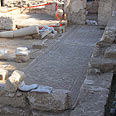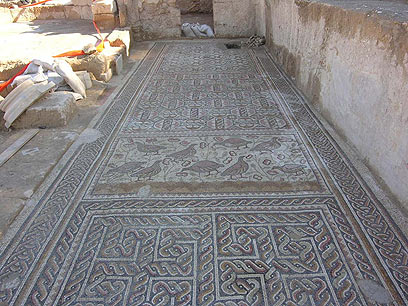
1,500 year-old Byzantine Church unearthed
Basilica discovered in Judean Hills said to have exquisitely preserved mosaics in use between 5th and 7th centuries C.E.
Archeologists last week announced the discovery of a small Byzantine basilica with exquisitely preserved mosaics in use between the 5th and 7th centuries C.E., located on an uninhabited hill south-west of Jerusalem.
Site leader, Amir Ganor of the Israel Antiquities Authority (IAA) said the floor was "one of the most beautiful mosaics to be uncovered in Israel in recent years."
"It is unique in its craftsmanship and level of preservation," he also stated.
The surprisingly well preserved floor depicts peacocks, lions, foxes, and fish.

Mosaic floor (photo courtesy of Israel Antiquities Authority)
Excavation of the site, known as Hirbet Madras, commenced in December after the IAA discovered several months previously, that antiquities thieves were plundering the ruins.
Initially thought to be a synagogue, further excavation revealed stones carved with crosses. The church was built atop another structure some 500 years older, believed to be Jewish.
“Hirbet Madras is known as the site of a large, important Jewish community from the Second Temple period until its destruction during the Bar Kokhba Revolt in 135 CE.
"Among the remains at the site are buildings, caves, agricultural instillations and extensive underground hiding tunnels. The site was identified by a number of scholars as the location of a major community.” the Israel Antiquities Authority said in a press release.
The church was to be visible for another week, before the mosaics are covered with earth for their own protection, and funding can be obtained to open it as tourist site.
Reprinted with permission from Shalom Life
- Follow Ynetnews on Facebook










